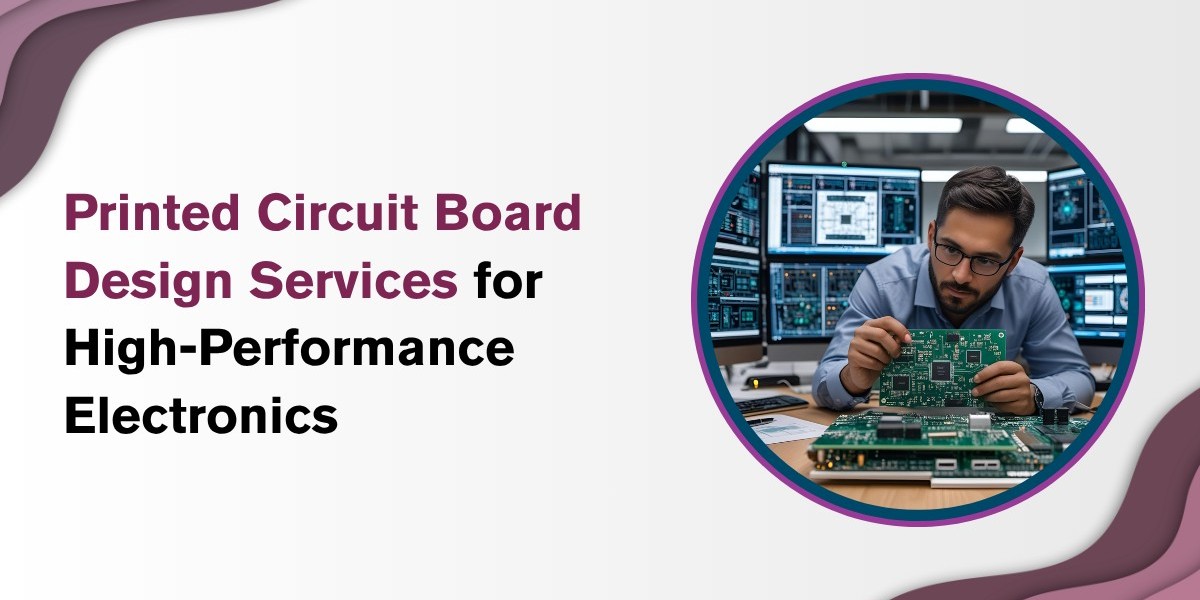Printed Circuit Boards (PCBs) are at the core of all modern electronic devices. They provide the physical platform for electronic components and ensure proper electrical connectivity. For high-performance electronics, such as aerospace systems, 5G infrastructure, advanced automotive technologies, and medical devices, PCB design requirements become much more critical. These systems demand higher speed, better reliability, and more precise design execution.
What Is Printed Circuit Board Design?
Printed Circuit Board Design is the process of creating the layout of a PCB that interconnects electronic components using conductive tracks, pads, and other features. This involves schematic design, component placement, routing of traces, signal integrity analysis, and preparing files for manufacturing.
High-Performance Electronics: Why PCB Design Is Critical
High-performance electronics operate under more demanding conditions. These include high-frequency signals, fast switching speeds, and thermal constraints. Poor PCB design in such cases can lead to signal degradation, heat issues, or system failures.
Key sectors using high-performance PCB designs:
Telecommunications: Supports 5G, fiber optics, and broadband.
Automotive: Used in electric vehicles, ADAS, and infotainment systems.
Medical: Found in imaging devices and monitoring systems.
Industrial: Powers control systems, robotics, and sensors.
Consumer Electronics: Essential in smartphones, gaming systems, and smartwatches.
Core Elements of Printed Circuit Board Design Services
Printed Circuit Board Design Services involve several phases. Each step contributes to the final product's performance, quality, and reliability.
1. Schematic Capture
Electrical circuit diagrams are developed.
Defines how components are electrically connected.
Establishes the logical functionality of the system.
2. Component Selection and Placement
Appropriate components are selected based on electrical and mechanical requirements.
Placement affects trace length, electromagnetic interference (EMI), and thermal flow.
Optimized layout ensures space efficiency and signal quality.
3. PCB Layer Stack-Up Design
Multilayer PCBs are standard for high-speed circuits.
Layers are arranged for signal, power, and ground planes.
Proper stack-up design controls impedance and minimizes noise.
4. Trace Routing
Copper traces connect different components electrically.
Trace width and spacing determine impedance and current capacity.
Controlled impedance is essential for high-speed signal transmission.
5. Signal Integrity and Power Integrity
Signal quality is evaluated using simulation and modeling.
Issues like crosstalk, reflections, and ground bounce are minimized.
Power distribution is stabilized with proper plane design and decoupling.
6. Thermal Management
Heat sinks, thermal vias, and copper planes aid in heat dissipation.
Design considerations ensure components like CPUs and power ICs remain within safe temperature ranges.
Critical for maintaining performance and longevity.
7. Design for Manufacturability (DFM)
Ensures the PCB design meets manufacturing process capabilities.
Rules are applied for trace widths, pad sizes, hole diameters, and spacing.
Reduces production errors and increases yield.
Advanced Technologies in PCB Design for High Performance
Designing PCBs for high-speed and high-frequency operations requires the use of modern technologies and materials.
1. High-Density Interconnect (HDI)
High-Density Interconnect (HDI) PCBs support more components in limited space by using microvias, blind vias, and buried vias. These advanced interconnects are ideal for compact devices like smartphones, tablets, and IoT products, where high performance and miniaturization are critical.
2. Use of Advanced Materials
While FR-4 is commonly used in PCB fabrication, it may not perform well at high frequencies. Advanced materials like PTFE, ceramic, and polyimide offer low dielectric loss and better thermal properties, reducing signal distortion in high-speed, high-frequency circuits.
3. Embedded Components
Embedded components are mounted within the PCB substrate rather than on its surface. This technique saves board space, shortens electrical paths, and reduces parasitic inductance and capacitance, making it ideal for high-speed circuits and miniaturized electronic systems with strict space constraints.
4. Rigid-Flex and Flexible PCBs
Rigid-flex and flexible PCBs combine rigid and flexible materials, enabling design versatility in compact, complex products. These boards are widely used in aerospace, military, and wearable electronics due to their durability, space efficiency, and resistance to mechanical stress and vibration.
Challenges in High-Performance PCB Design
1. Signal Integrity
High-speed signals are highly affected by impedance mismatches and electrical noise. To maintain signal quality, designers use uniform trace widths, match trace lengths, and apply proper terminations. Techniques like shielding and routing differential pairs also help reduce interference and distortion.
2. Electromagnetic Interference (EMI)
Faster switching speeds in high-performance electronics increase electromagnetic interference. Effective EMI control requires careful trace layout, minimized loop areas, and optimized return paths. Proper grounding techniques and component placement are essential to limit emissions and maintain compliance with regulatory standards.
3. Heat Dissipation
As component density rises, so does thermal stress. Efficient heat dissipation is achieved using thermal vias, wide copper planes, and heat sinks. Thermal design must ensure that critical components operate within safe temperature limits to avoid damage or reduced lifespan.
4. Manufacturing Limitations
High-performance PCB designs often push the limits of fabrication. Smaller features, tighter tolerances, and multiple layers require advanced equipment and expertise. Not all manufacturers can meet these demands, especially when exotic materials or precise alignment processes are involved in production.
Best Practices for High-Performance PCB Design
1. Maintain Controlled Impedance
Controlled impedance is crucial for maintaining signal integrity in high-speed designs. Trace width, spacing, and dielectric properties must be carefully managed to keep impedance consistent across signal paths, preventing reflections and losses in interfaces like DDR, PCIe, and high-speed serial links.
2. Use Ground and Power Planes
Dedicated ground and power planes help stabilize voltage levels, reduce noise, and improve return current flow. They also assist in minimizing electromagnetic interference by creating low-impedance paths, which is vital for maintaining signal quality in multilayer high-speed PCBs.
3. Optimize Layer Stack-Up
An optimized PCB layer stack-up supports impedance control, signal isolation, and EMI reduction. Proper arrangement of signal, ground, and power layers enhances electrical performance, improves thermal distribution, and provides a stable mechanical structure for complex, high-speed electronic assemblies.
4. Shorter Trace Lengths
Keeping trace lengths short reduces propagation delay and limits signal degradation. It’s important to avoid unnecessary vias or bends, as they can introduce impedance discontinuities. Shorter and straighter paths improve timing and signal fidelity, especially in critical data lines.
5. Route Differential Pairs Carefully
Differential pairs, used in USB, HDMI, and Ethernet, must be routed close together and matched in length. This ensures equal delay and maintains signal integrity. Any imbalance in length or spacing can cause skew, reducing the effectiveness of differential signaling.
6. Validate With Simulations
Pre-layout and post-layout simulations help identify issues in signal integrity, power distribution, and thermal behavior. Tools like SPICE, SI/PI analyzers, and thermal solvers can reveal design flaws early, reducing the risk of failures during physical testing or production.
7. Review DFM and DFA
Design for Manufacturability (DFM) and Design for Assembly (DFA) reviews ensure the PCB design aligns with production capabilities. This includes checking spacing, tolerances, and test point accessibility. Early validation avoids rework, lowers cost, and ensures smooth transition to fabrication and assembly.
Collaboration with PCB Design Services
Working with experienced PCB design services brings several benefits:
Access to specialized tools like Altium, OrCAD, or Mentor Graphics.
Knowledge of IPC standards and reliability testing.
Support for component selection based on availability and longevity.
Assistance with prototype development and testing.
Integration with manufacturing partners for seamless production.
Conclusion
Printed Circuit Board Design Services are essential for building reliable, efficient, and compact high-performance electronic systems. As device complexity increases, careful attention to every phase of PCB design is vital. From selecting materials to managing heat and signal integrity, each step influences the final performance.
High-performance electronics are growing across all industries. PCB design must evolve to meet their increasing demands. With skilled services, advanced tools, and solid engineering practices, successful outcomes become achievable even under the most stringent conditions.
































